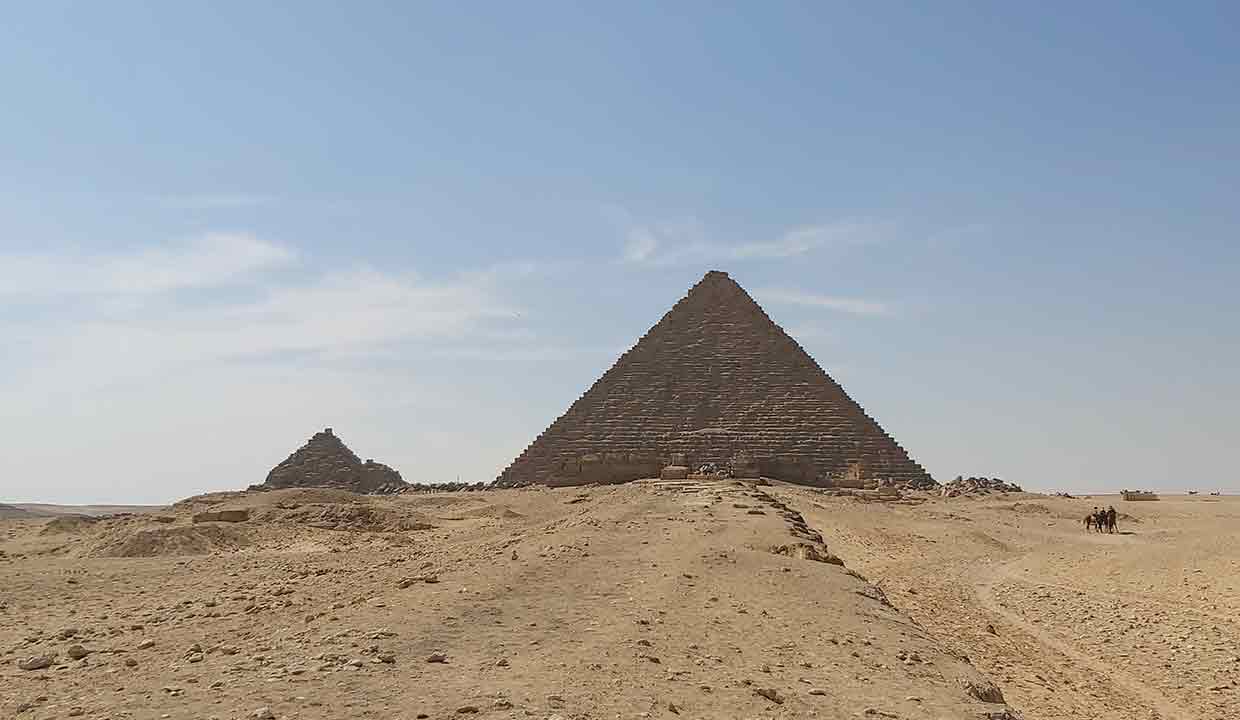Journey to Giza’s hidden gem – the Pyramid of Menkaure. Its walls guard millennia-old stories, architectural marvels, and the heartbeat of an empire.
The Giza Plateau in the southwestern outskirts of Cairo, Egypt, is home to some of the most iconic structures of the ancient world – the three main pyramids. While the Pyramid of Khufu and the Pyramid of Khafre often steal the limelight due to their massive sizes, the Pyramid of Menkaure, though the smallest, holds a unique significance and myriad secrets of its own.
Historical Overview:
Named after the Pharaoh Menkaure of the Fourth Dynasty, who reigned around 2532-2503 BCE, this pyramid marks the zenith of pyramid-building techniques, combining both size and detailed artisanship. It is said that Menkaure wished to make his eternal resting place a perfect balance of grandeur, intricacy, and spirituality.
Dimensions and Structure:
Standing at approximately 65 meters (213 feet) tall, the Pyramid of Menkaure is significantly shorter than its two neighbors. Originally, it was about 71 meters but lost some height due to erosion and removal of its outer casing stones. Covering a base area of 103.4 meters by 104.6 meters, the pyramid’s compact dimensions are thought to represent a shift in priorities from sheer magnitude to subtler, more intricate architectural elements.
The pyramid’s core is made up of irregular blocks of limestone, relatively smaller than those used in the previous pyramids. Interestingly, the lower course of the pyramid was initially built using high-quality red granite, a material usually reserved for interior chambers or finer details.
Internal Chambers:
The Pyramid of Menkaure, like its counterparts, has a complex internal structure. Its main entrance is situated on the northern side, leading downwards into a descending corridor. This corridor eventually reaches the lower burial chamber, which is directly carved into the bedrock, an architectural feature that differentiates it from the other Giza pyramids.
There’s also an ascending corridor leading to an antechamber and the main burial chamber. The burial chamber’s ceiling is gabled, mimicking the slanting sides of the pyramid. The room once held a basalt sarcophagus, intricately carved, which unfortunately was lost at sea during transportation to England in the 19th century.
Temples and Surroundings:
To the east of the pyramid lies the Mortuary Temple of Menkaure. Though smaller and simpler than those of Khufu and Khafre, it contains invaluable statues of Menkaure, often paired with various deities. The most famous among these statues are those of Menkaure with his queen and Menkaure with various deities, demonstrating a blend of realism and idealization that showcases the exceptional artistry of the Old Kingdom.
Additionally, three smaller “satellite” pyramids are associated with Menkaure’s pyramid. These were most likely intended for royal consorts and are unique due to the fact that they each have their own individual mortuary temples and subsidiary structures.
Cultural and Archaeological Significance:
Though smaller, the Pyramid of Menkaure is essential in the Giza landscape. Its deviation in design and choice of materials offers scholars insights into the architectural, cultural, and socio-political shifts of the Old Kingdom. The pyramid stands as a testament to the diverse ways the ancient Egyptians conceptualized the journey to the afterlife, emphasizing that size wasn’t the only measure of a pharaoh’s aspiration to eternity.
In conclusion, the Pyramid of Menkaure, while dwarfed by its larger neighbors, holds its ground as a unique masterpiece, blending royal ambition with architectural innovation. It serves as a poignant reminder that sometimes, in the quest for immortality, it’s not just the size, but the depth of thought and intricacy of design that truly matters.
The Pyramid’s Role in Giza’s Astronomical Alignment:
One of the most intriguing facets of the Giza complex is the alignment of the pyramids. Ancient Egyptians had a deep understanding of astronomy, and their structures often encapsulated these celestial insights. The three pyramids of Giza are aligned with the Orion’s Belt constellation, a trio of stars that held great significance in Egyptian cosmology. While Menkaure’s pyramid is the smallest, its precise positioning is integral to this alignment, reaffirming its essential role in the grand design.
Restoration and Conservation Efforts:
Over millennia, the Giza pyramids have faced the ravages of time, environmental factors, and human interference. While Menkaure’s pyramid has remained relatively intact compared to its larger counterparts, it hasn’t been without its share of damages. The casing stones, for instance, were stripped away during the Middle Ages, impacting its once pristine façade.
In recent decades, there has been a renewed effort by the Egyptian government and international bodies to restore and conserve the Giza pyramids. Menkaure’s pyramid has benefited from these conservation missions, which aim to stabilize its structure, restore parts of its exterior where possible, and improve tourist amenities to ensure a more sustainable interaction with the monument.
The Pyramid in Modern Culture:
Despite its smaller stature, the Pyramid of Menkaure has not escaped modern cultural references. It appears in various literature, documentaries, and artwork as a symbol of perseverance and subtlety amidst grandiosity. Artists and writers often use it as a metaphor for the idea that greatness doesn’t always equate to size, but sometimes to the finer details and the depth of one’s convictions.
Furthermore, it has become a focal point for many alternative theories and speculations. While most of these lack a basis in academic archaeology, they nevertheless underscore the pyramid’s enduring allure and its ability to captivate the imagination.
Conclusion:
The Pyramid of Menkaure may not have the imposing stature of its neighbors, but its unique characteristics and rich history make it a monument of paramount importance. It offers a nuanced understanding of the ancient Egyptian civilization, showcasing their evolving architectural techniques, artistic sensibilities, and spiritual beliefs. As we gaze upon this architectural marvel, we’re reminded that every stone has a story, every corridor echoes with whispers of the past, and true greatness often lies in the details. In the shadow of giants, Menkaure’s pyramid shines with its own distinct light.
